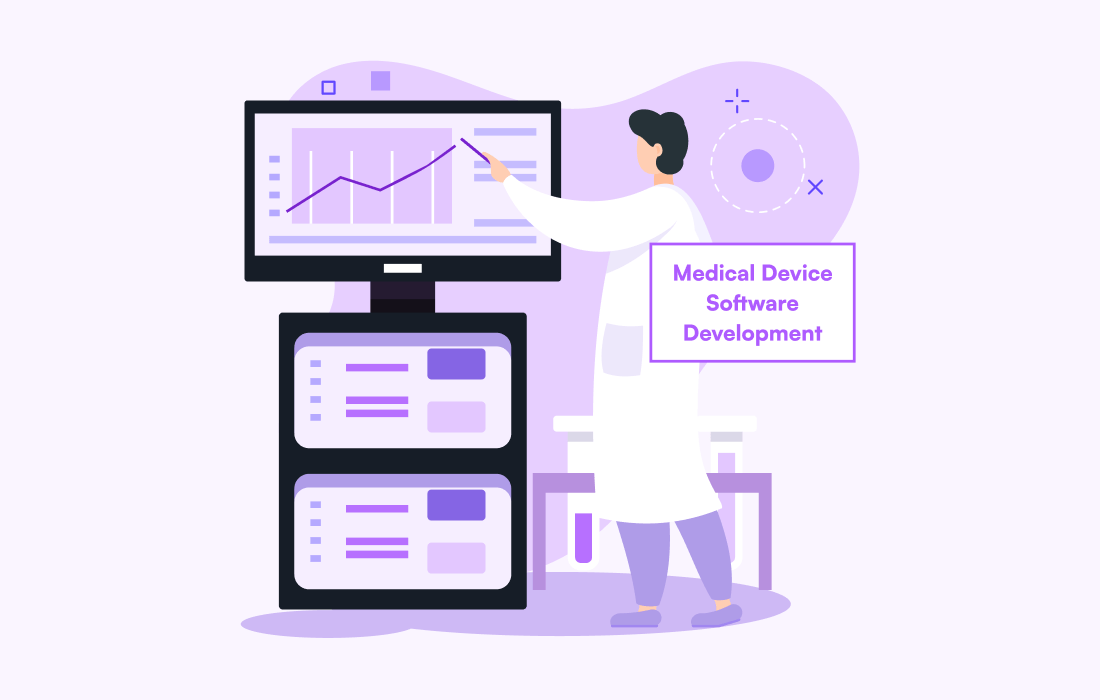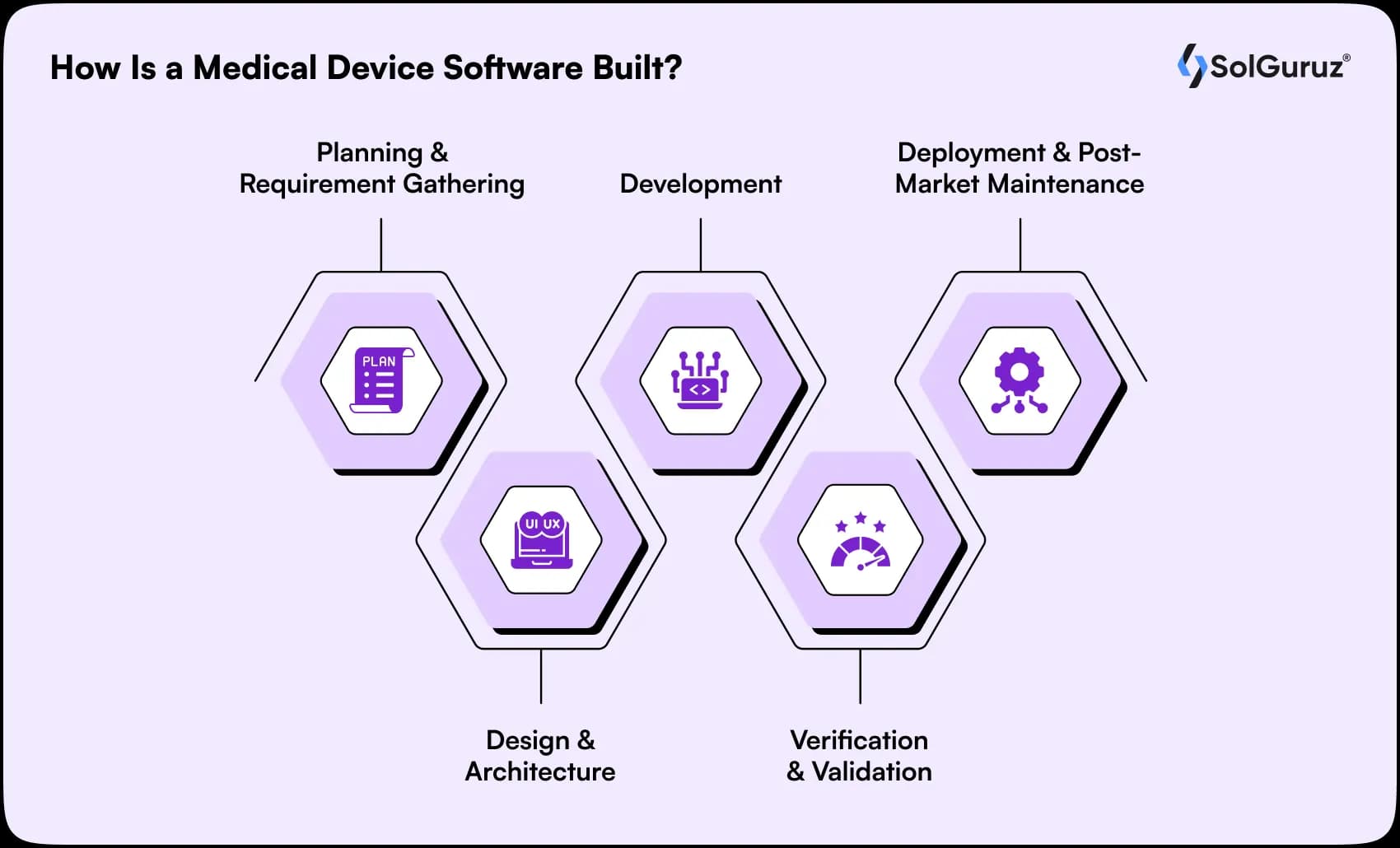Medical Device Software Development: A Complete 2025 Guide
If you’re exploring medical device software development, this step-by-step guide explains how it works, how much it costs, and what to expect. Written for founders aiming to build compliant, high-performing healthcare products.

Medical device software makes modern healthcare work.
Every beep of a heart monitor, every image on an MRI screen, every alert from a wearable. There’s software running quietly behind it.
Building it is an altogether different task.
Why? Because you are not just coding here, you are actually engineering something that could directly impact a patient’s life.
And in this guide, we’ll walk through how medical device software is built, the challenges teams face, and what it really costs to do it right.
Table of Contents
What Exactly Is Medical Device Software Development?
If I were to explain in simple terms. Medical device software development is nothing but the process of building robust software that supports a medical device.
This could mean the software running inside a device (like a pacemaker controller). Or a software that works with a device. Like a mobile app that monitors patient vitals.
And unlike a regular app development, this process isn’t just about functionality or user experience. It’s about safety, precision, and regulatory compliance.
Every workflow and every data exchange must be traceable and verifiable. Why? Because human lives might depend on it.
Regulators and international standards define strict frameworks to ensure that medical device software is properly built, tested, and maintained according to proven quality systems.
In simpler terms, you are building technology that needs to earn official approval before it can be used.
Types of Medical Device Software
Not all medical device software is built the same way.
Some live inside physical devices, others work alongside them.
Let’s try to understand them because these distinctions are crucial before we go into the medical software development lifecycle.

1. Embedded Software
This is the type of software that works inside the device. Kinda like a brain.
Take the example of a pacemaker that adjusts heartbeat rhythms or an insulin pump that controls dosage.
The main thing is, everything is happening in real-time. So, the software needs to be reliable.
If there’s even a small glitch, the device itself could fail. Which is why testing and certification take center stage here.
2. Software as a Medical Device
This type doesn’t rely on any hardware.
It’s pure software. It can be a mobile app, a web platform, or an AI tool that performs medical functions on its own.
Let’s take an example: a simple app that analyses X-rays can be counted under this umbrella.
As you can see from the above example, it can directly influence medical decisions. Hence, it has to go through one of the most rigorous regulatory reviews.
3. Software in a Medical Device
This one sits somewhere in between. It’s built into the device but not the device’s “main” logic.
Simple example: a display system on an MRI machine or the control interface for an oxygen monitor.
It doesn’t make medical judgments, but still needs to be stable, accurate, and well-tested.
4. Companion or Supporting Apps
Then there are apps that support a medical device. Like a mobile dashboard showing readings from a wearable ECG. Or an app that syncs data with a hospital system.
These might not be classified as “medical devices,” but they still handle sensitive data.
For more details, check out our blog on healthcare software development. We have covered costs, features, and process in detail.
How Is a Medical Device Software Built?

Now this part is actually simple. But definitely not easy.
The thing is, there’s a lot of structure, documentation, and validation involved. And one small oversight can mess things up.
And in the last 5 years, I’ve seen that the best medical software projects start with clarity.
Here’s a simple way to look at the process:
1. Planning and Requirement Gathering
Every successful project begins here.
Why? Because this is where you define what the software needs to do, how it will interact with the device, and what regulations apply.
And… Founders often underestimate this phase. And the most fun part? The more you plan here, the fewer surprises you’ll face later.
Regulators love seeing this level of preparedness.
2. Design and Architecture
Once requirements are crystal clear, the design phase kicks in.
This isn’t just about UI. It’s about how the software will function safely and predictably.
Developers design the architecture, define data flow, and ensure that every component can be traced back to a requirement (a must for compliance).
Good teams also start building the traceability matrix here. It is like connecting every feature to a documented need or safety requirement.
3. Development
This is where the code finally starts coming to life.
Developers follow strict coding standards and documentation practices. Every commit and every line of logic needs to be auditable.
On the other side, testers need to work alongside developers. This will help you run tests and catch issues early.
A good rule of thumb: build small, test fast, document everything.
4. Verification and Validation
In regular app development, “testing” often happens toward the end.
In medical software, it happens at every stage.
Verification checks whether you built the software correctly. Kinda like, does it match the specs?
While validation ensures you built the right thing (does it meet user and patient needs?).
This phase can be intense. It can involve multiple rounds of documentation, audits, and reviews. But this is what separates compliant products from risky ones.
5. Deployment and Post-Market Maintenance
Even after launch, the work doesn’t stop.
You need to document each and every software update. No matter how small.
Why? Let’s say a new feature affects the device’s performance or safety. It may even require a regulatory re-approval.
That’s why experienced teams are always prepared for this. They build processes for ongoing monitoring and post-market surveillance.
How Much Does It Cost to Develop a Medical Device Software?
Let’s be honest. This is the question almost every founder asks first.
And rightly so. Developing medical device software isn’t cheap, but it’s also not as unpredictable as it looks once you understand what drives the cost.
Over the years, I’ve noticed one thing: two projects can look similar on paper and still differ by 3x in cost.
Here’s a simple breakdown of what really shapes the budget.
1. Type and Complexity of the Software
A simple monitoring dashboard or mobile app that connects to a wearable might cost $10,000–$40,000.
But if you’re building a Class II or III software that analyzes medical data, integrates AI, or automates decision support, it can easily cross $80,000–$150,000+.
The higher the risk classification, the more documentation, testing, and audits you’ll need. And that’s where costs add up fast.
2. Regulatory Compliance
This is one of the biggest cost drivers.
Meeting standards (like FDA, MDR, or IEC 62304) means your development process must be fully documented and traceable.
So, even if you’re building a simple app. Once it’s labeled “medical,” you need to be prepared for dedicated QA teams and validation experts.
And possibly regulatory consultants, which adds another 20–30% to your total cost.
3. Design and Usability Requirements
In healthcare, usability isn’t just about nice buttons or clean design. It’s about reducing user errors.
User interface testing, prototyping, and accessibility adjustments all require time (and sometimes specialized UX researchers).
Expect $7,000–$9000 here, depending on how many iterations you do.
4. Integration and Testing
If your software connects with hardware, hospitals’ EHRs, or cloud systems, integration testing becomes a project of its own.
Hardware simulations, interoperability testing, and validation environments can cost $15,000–$40,000.
5. Post-Market Support and Maintenance
Once your device is approved, you can’t just push updates like a regular app.
Even small code changes need verification and documentation.
Plan for 15–25% of your development cost annually for ongoing support, updates, and compliance checks.
Some Major Challenges While Developing a Medical Device Software

If you’re getting into medical device software for the first time, it’s easy to underestimate how complex it can get.
It’s not the coding that makes it hard. It’s the constant balancing act between innovation, safety, and regulation.
Here are a few challenges I’ve seen almost every medtech project face at some point.
1. Navigating Regulations (Without Losing Momentum)
Let’s start with the obvious one.
Regulations are there for a reason. Period. But you can feel lost when you’re just starting out.
Different regions have different standards.
The hard part isn’t just complying. It’s building your product while keeping everything perfectly aligned.
Many startups try to “figure it out later” and end up wasting months fixing documentation gaps.
2. Managing Complexity Between Hardware and Software
When your software interacts with hardware, things can get tricky.
The thing is, small hardware updates can break your software’s behavior, and vice versa.
You’ll need tight integration testing, version control, and sometimes hardware simulators just to stay in sync.
In one project we saw, a single firmware update changed a data field, and the app started showing incorrect readings. It took weeks to trace that.
3. Ensuring Data Security and Privacy
Medical data is gold and a huge responsibility.
If your app stores or transmits patient information, it must comply with regional privacy laws.
Remember: it’s not just about protecting users; it’s also about earning the trust of hospitals, regulators, and investors.
4. Testing & Then Testing Again
Testing in medical software isn’t a single step. It is developed throughout the lifecycle.
Every change needs to be verified, validated, and documented.
That’s why testing often takes as much time as development itself.
It might feel repetitive, but this is what separates safe medical devices from “risky prototypes.”
5. Keeping Documentation Up-to-Date
This one sounds boring, but it causes more delays than you’d imagine.
Your design docs, risk logs, and test reports must stay synced with the product. And they must survive audits.
Teams that treat documentation as an afterthought almost always regret it later.
Why Partner With an Experienced Medical Software Development Company?
If you’re serious about bringing your medical device idea to life. That too, without drowning in documentation or delays. Having the right partner by your side is worth it.
At SolGuruz, we’ve helped medtech startups and healthcare innovators design, develop, and validate compliant software that actually passes audits and reaches the market.
From concept to certification, our team handles both the tech and the trail of paperwork that goes with it.
Need help building your medical device software?
Let’s talk about how we can help you launch it the right way.
FAQs
1. Is an app that tracks heart rate or blood pressure considered medical software?
It depends. If the app only tracks general fitness data, it’s not. But if it claims to diagnose, predict, or guide treatment. Then it likely falls under the category of regulated medical device software.
2. How long does it take to build medical device software?
Typically 6–18 months, depending on complexity, device type, and the regulatory pathway. Pre-market documentation and validation can take up a major chunk of time.
3. Can startups build medical device software without prior experience?
Yes, but it’s risky to go solo. Partnering with a team experienced in healthcare regulations saves you time, prevents compliance issues, and ensures smoother FDA or MDR approvals.
4. What technologies are commonly used?
Modern stacks like Flutter, React Native, and .NET for frontends; Python, Node.js, or Java for backends. But the real focus is on security, traceability, and compliance documentation.
5. What happens after launch?
Medical device software needs post-market surveillance. Like continuous monitoring, bug tracking, and safety updates to stay compliant and ensure patient safety.
Have a Medical Software Idea in Mind?
Let’s make sure it passes every regulatory checkpoint with ease.

Strict NDA

Trusted by Startups & Enterprises Worldwide

Flexible Engagement Models

1 Week Risk-Free Trial
Give us a call now!

+1 (724) 577-7737


